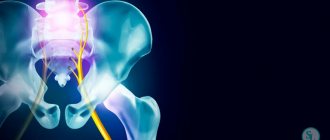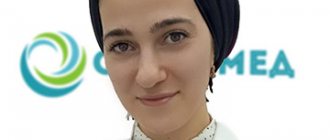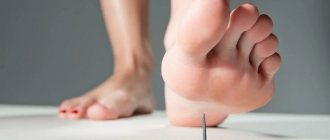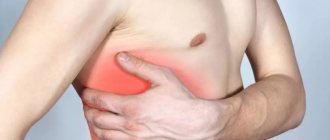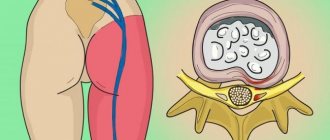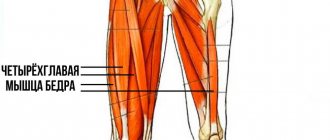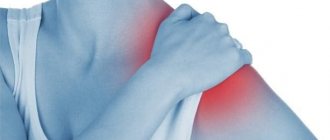Patients often come to the CELT Pain Clinic with complaints that their sciatic nerve hurts. The cause of this phenomenon is sciatica: inflammation of the sciatic nerve, which can occur even in absolutely healthy people. The sciatic nerve is a paired nerve of the sacral plexus, which is the thickest and longest in the human body. It begins in the lumbar region, passes through the tailbone, the back of the pelvis, along the legs and reaches the feet.
That is why, when the sciatic nerve hurts, pain symptoms spread to the lower back and lower limbs. Sciatica is not a separate disease; as a rule, it occurs as a result of other diseases. If you have sciatic nerve pain and don't know what to do, contact our Pain Clinic. It is very important to promptly identify the cause of such symptoms and begin treatment of the primary disease.
At CELT you can get advice from a specialist algologist.
Make an appointment
Reasons why the sciatic nerve hurts
Sciatica (or, as it is also called, sciatic neuralgia) occurs due to the following diseases:
- Osteochondrosis of the lumbosacral spine. Pathological changes in the intervertebral discs cause a decrease in the distance between the vertebrae and lead to compression of the sciatic nerve;
- Intervertebral hernia of the lumbar region. In this case, compression of the sciatic nerve is caused by protrusion of the hernia towards the spinal canal;
- Spondylolisthesis. Instability of the spine in this disease leads to displacement of the vertebrae, and consequently to pinching of the sciatic nerve with the development of inflammatory processes;
- Dislocation or subluxation of the sacroiliac joint;
- Lumbar spinal canal stenosis. Excessive formation of soft tissue leads to a narrowing of the canal through which the spinal cord passes. All this leads to excessive pressure of the intervertebral discs on the nerve roots;
- Piriformis syndrome. The sciatic nerve passes under or through the piriformis muscle, which can cause irritation and inflammation.
What should you avoid if you have sciatica?
First of all, you should avoid hypothermia: do not stay in the cold or open wind for a long time, do not lie on cold surfaces, do not swim in cold water. To strengthen the immune system, you need to strengthen the body with exercise therapy, water treatments, yoga, and massage.
It will be important to change your occupation if it involves heavy physical work. It is also necessary to limit long stays in one position, sharp bends and turns of the body, running, fast walking, and transferring the entire body weight to the affected leg.
If you tend to be overweight, it is recommended to create a diet. Excess weight will aggravate the inflammatory process and increase pain.
Clinical manifestations of sciatica
In most cases, one of the sciatic nerves is affected, so the pain is localized on one side, but damage to both nerves also occurs. When the sciatic nerve hurts, treatment is primarily aimed at reducing pain. They can be so strong that the patient cannot move not only the limbs, but also the torso, since each of them (including deep inhalations/exhalations) increases the pain. It has a shooting or burning character and radiates to the buttock and leg. In addition, the following clinical manifestations are observed:
- impaired skin sensitivity in the lumbar and gluteal regions, as well as legs;
- muscle weakness in the groin, lower extremities and fingers, paralysis;
- the patient is forced to take a position in which pain is reduced;
- attacks of pain occur due to stress, hypothermia, sudden movements;
- sexual disorders and fecal and urinary incontinence in the most severe cases.
What to do in case of an attack of pain?
At the first stage, first of all, you should observe bed rest, limit any movements, it is better to take a pose with support on your healthy leg. When lying on your back, it is recommended to place a small pillow under your lower back and knees. If you cannot lie down, you should shift your weight from one leg to the other alternately and move more often. With light dynamic movements, the muscles relax faster. Take pain medication as prescribed by your doctor.
At the second stage, you can use dry heating (a warm heating pad, a heat-retaining blanket) or a compress with herbal tinctures on the affected area. It is not recommended to use heat at elevated temperatures. In the absence of contraindications, you can perform a massage with rubbing and kneading of the lumbar region and limbs.
To prevent relapses, it will be useful to wear a fixing corset, and for pregnant women, a prenatal bandage if there is a noticeable increase in the abdomen. All intramuscular injections should be performed by trained medical personnel and placed only in the unaffected leg.
Diagnosis of sciatic nerve pain
Is your sciatic nerve hurting and you don’t know how to treat it? Seek medical help! Specialists at the CELT Pain Clinic will find out the cause that caused this disease and prescribe its effective treatment. Before starting it, our doctors examine the patient, check reflexes and determine skin sensitivity and collect anamnesis. In addition, it is prescribed:
- X-ray examination;
- CT scan;
- Magnetic resonance imaging.
If the presence of a tumor in the spine is suspected, a radioisotope diagnostic study is prescribed.
Disease prevention
To prevent the development of lumboischialgia, it is recommended:
- eat rationally;
- move more often;
- exercise;
- perform exercises that strengthen the back muscles and stretch the muscles;
- when doing physical work, use the principles of biomechanics;
- balance the load with the body’s capabilities;
- fight excess weight;
- promptly treat diseases of the spine, blood vessels and digestive system;
- don't get too cold.
Treatment of sciatic nerve pain
To successfully treat sciatic nerve pain, the CELT Pain Clinic uses modern techniques:
- Physiotherapy - aimed at reducing pain, improving blood circulation and relieving swelling and may include: UHF therapy, electrophoresis, laser and magnetic therapy, paraffin applications;
- Systemic therapy involves the use of non-steroidal anti-inflammatory drugs. Their use should be regulated by a doctor, since they have a number of side effects. In addition, anticonvulsants can be prescribed, which are extremely effective in treating neuralgia. In addition, drugs are used that relieve pain symptoms quickly. They can be prescribed either as tablets or as injections. Our Pain Clinic uses only modern, effective means.
- Blockades aimed at the affected area. Depending on the problem causing the pain, different medications may be used to block the pain. To control the accuracy of delivery of the medicine to the problem area, we use an X-ray unit or ultrasound machine.
Do you want to be healthy and eliminate pain attacks from your life? Contact the CELT Pain Clinic!
Make an appointment through the application or by calling +7 +7 We work every day:
- Monday—Friday: 8.00—20.00
- Saturday: 8.00–18.00
- Sunday is a day off
The nearest metro and MCC stations to the clinic:
- Highway of Enthusiasts or Perovo
- Partisan
- Enthusiast Highway
Driving directions
Symptoms of the disease
The most important symptoms of sciatic nerve sciatica are:
- pain localized in any part of the body along the passage of the nerve fiber: in the lower back, buttock, back of the thigh, lower leg, foot;
- loss of sensitivity, numbness of the lower limb along the nerve fiber;
- paresthesia - tingling sensations, “pins and needles” in the foot and toes.
The nature of the pain is most often shooting, but it can also be burning, dull, aching, etc. During periods of exacerbation, when moving the spine or leg, it can intensify and become unbearable. As a rule, the disease affects one limb, but sometimes pain appears in both legs at once. In the most severe cases, the disease leads to paralysis of the leg muscles, sometimes spreading to the pelvic muscles, causing urinary and fecal incontinence in the patient.
Treatment
When treating sciatica, the basis of complex therapy is medications, which are used both in the acute phase of the disease to relieve pain, and for the rehabilitation of patients with a chronic course¹. Surgical treatment does not give a 100% result, but in some cases it is necessary because it avoids disability [1] [2].
Surgical
Surgical treatment is indicated for intervertebral hernias and is aimed at eliminating compression of the spinal cord roots, as well as the vessels that are responsible for its blood supply.
The absolute indication for surgical intervention is acute compression of the spinal cord roots, as a result of which the patient develops motor disorders, as well as disorders of sensitivity and function of the pelvic organs [1] [2].
Relative indications include instability of spinal motion segments and lack of visible improvements after several months of conservative treatment. Operations are performed using both open and endoscopic methods. The advantage of the endoscopic method is that it is minimally invasive and the patient is left with virtually no scars.
Medication
Medications in the treatment of lumbosacral radiculopathy help relieve pain, relieve inflammation and reduce muscle spasm. The following groups of drugs are used:
- Analgesics and non-steroidal anti-inflammatory drugs (flupirtine, ketoprofen, meloxicam, diclofenac).
- Chondroprotectors - used to improve the condition of cartilage tissue (chondroitin, glucosamine).
- Lipoic acid and B vitamins.
- Vasoactive drugs and agents to improve microcirculation (pentoxifylline, hexobendine).
- Muscle relaxants (baclofen, tolperisone, tizanidine).
- Antioxidants and antihypoxants (ethylmethylhydroxypyridine succinate, carnitine chloride, idebenone).
- Anticonvulsants (gabapentin, valproic acid, carbamazepine, phenytoin, pregabalin).
Don't lie down for a long time!
In the acute stage of the disease, when the pain is especially intense, bed rest is recommended. It is important to remember that it should last a maximum of 5 days. Otherwise, the course of the disease may worsen².
Non-drug
Acupuncture helps reduce pain and muscle spasms. It also helps to dilate blood vessels and improve local blood flow. The average course of treatment is 3 weeks. The procedure is contraindicated for local inflammatory phenomena on the skin, acute infectious and oncological diseases.
It is recommended to use local ointments and gels based on ketoprofen and diclofenac, as well as local application of dry heat. It is allowed to use irritating agents (for example, pepper patch). Outside of exacerbation, physiotherapeutic procedures are indicated: massage, physical therapy, electrophoresis, magnetic therapy³.
Massage
For sciatica, several types of massage are performed:
- Classic healing. Aimed at improving blood supply to muscles, and, if necessary, relaxing them.
- Point (shiatsu). It is believed that by stimulating the so-called biologically active points, an antispastic and analgesic effect is achieved. In recent years, this technique has become widely used in the treatment of radiculitis, but it should be remembered that it does not have a sufficient evidence base.
- Periosteal. The impact is carried out on pain points in the projection of the periosteum. Due to the reflex connection of the periosteum with muscles and organs, a relaxing and analgesic effect is achieved. Unlike acupressure, the effectiveness of this method has been confirmed by clinical studies. Periosteal massage is actively used for diseases of the musculoskeletal system.
The most widespread is classical therapeutic massage. This technique includes stroking, rubbing, kneading movements and vibration (patting, shaking movements). The back area, gluteal muscles and legs are massaged. Kneading movements when treating radiculitis should be moderately intense. The duration of the procedures increases from session to session. The first massage usually lasts no more than 15 minutes, and towards the middle of the course the session duration reaches 45 minutes.
Massage is better than classic
When visiting a private SPA salon, you may be recommended expensive types of massage (for example, chiromassage or chakra stone therapy).
For sciatica, these procedures will not give the expected result, since they are more designed for relaxation and lymphatic drainage. Classic therapeutic massage will cost much less and will provide a more noticeable therapeutic effect. It should be remembered that there are contraindications for massage:
- acute stage of radiculitis;
- pustular skin diseases;
- infectious viral diseases;
- liver and kidney pathologies;
- oncological neoplasms.
Massage for sciatica improves blood supply to the muscles. Photo: pressmaster / freepik.com
Physiotherapy
Despite the undeniable importance of drug therapy, therapeutic exercises should not be ignored. The doctor prescribes them for a comprehensive effect on the cause of the disease. Exercise therapy helps strengthen the muscle corset, which stabilizes the spinal column, as well as improve blood supply to the nerves and reduce swelling of the soft tissues. Exercises can be performed both in a medical facility and at home.
An example of a set of exercises for sciatica:
- Starting position: standing, feet shoulder-width apart. Arms bent at the elbows are located on the lower back. Perform the bends alternately: 8-10 bends to the left and to the right with a delay at the bottom point for 2-3 seconds.
- The starting position is the same. Without taking your hands off your lower back, bend forward and backward alternately, pausing briefly at the lowest point (at least 20 bends in total).
- Starting position: standing, legs slightly narrower than shoulder width, arms relaxed. Perform 10-15 downward bends, trying to reach the floor with your fingertips.
- Starting position: lying on your stomach, palms resting on the floor at the level of the thoracic region. Extend your back as much as possible and hold at the top point for a few seconds. At least 10 repetitions.
- Starting position: lying on your stomach, hands clasped behind your back. Slowly raise your head and shoulders, turning your head at the top point alternately to the right and left. At least 10 repetitions.
Important! Exercise therapy is contraindicated in the acute stage of sciatica, severe pain, severe arterial hypertension and heart failure. A set of exercises should be selected individually, taking into account the age, build, stage of the disease and general condition of the patient.
Figure 3. Therapeutic exercises for sciatica. Image: corbacserdar.gmail.com / Depositphotos
Diet
For lumbosacral radiculopathy, the diet is aimed at normalizing weight and blood pressure³. Weight must be normalized first of all in order to remove excess load from the spine. In addition, normalizing body weight in itself helps stabilize blood pressure.
First of all, you should reduce the calorie content of your daily diet. For this purpose, you need to give up confectionery products (or at least significantly limit their quantity). The same goes for fried and fatty foods.
It is important to eat more vegetables and fruits: white and cauliflower, broccoli, apples, plums. It is recommended to avoid fatty meats and fish. It is also advisable to exclude potatoes or reduce their consumption. As a side dish there can be buckwheat, pearl barley and wheat porridge, pasta made from durum wheat.
Eating spicy and salty foods is not recommended, as they retain water in the body, which contributes to the formation of edema and increased blood pressure.
Statistics
Sciatica is a fairly common disease in the age group from 35 to 50 years. It is at the most active age that the majority of initial visits to the doctor occur. The disease affects men more often than women. According to some experts, throughout their lives, up to 40% of people have at least once experienced an attack of pain in the sacral lumbar region, buttock or back of the thigh, but not all of these attacks become chronic and protracted. Cases of visiting a doctor are about 20-25 people per 100 thousand population.
Establishing diagnosis
This disease is characterized by a rather complex diagnosis, the first stage of which is conducting reflexology tests for flexion and extension of the leg. To finally clarify the clinical picture, the following is prescribed as necessary:
- lab tests;
- X-ray of the affected area;
- MRI;
- ;
- electroneuromyography;
- Ultrasound of the pelvic area.
The task of a neurologist is to identify symptoms characteristic of sciatica, and treatment should be aimed at eliminating the causes of nerve fiber compression.
